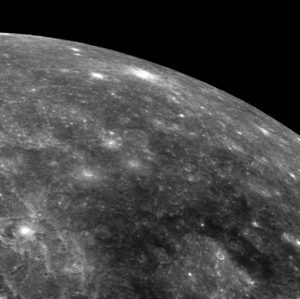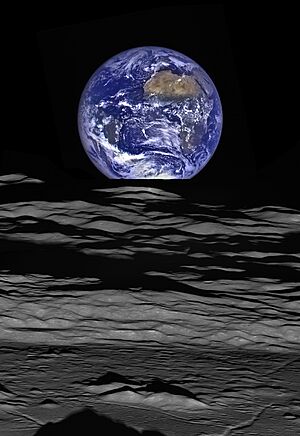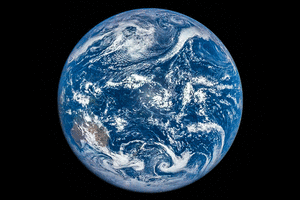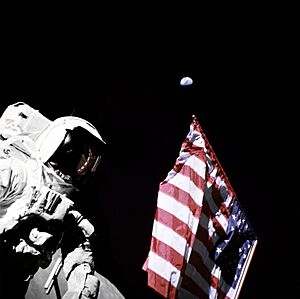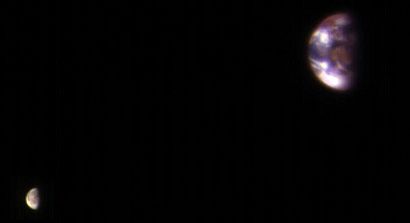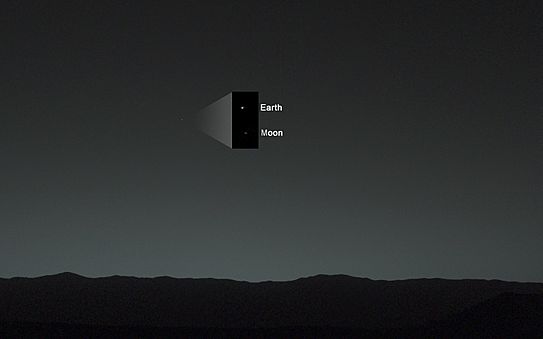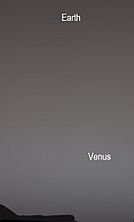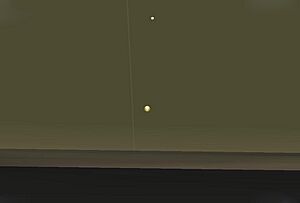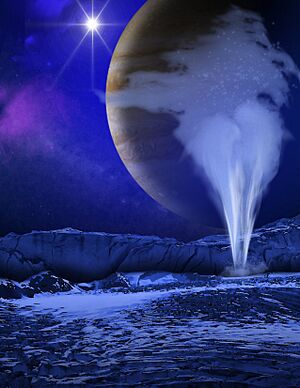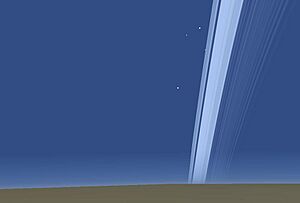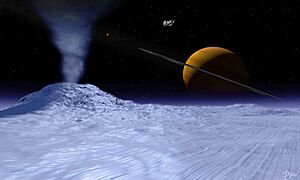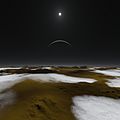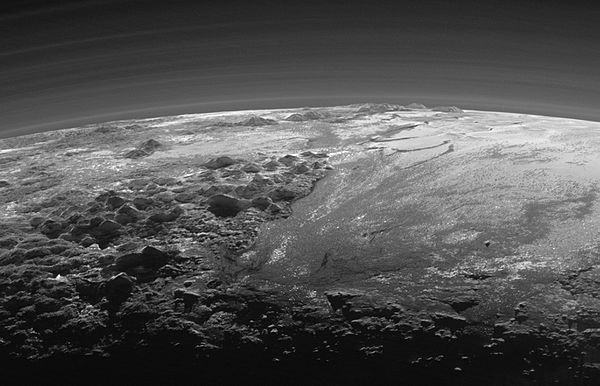Extraterrestrial sky facts for kids
An extraterrestrial sky is simply what the sky looks like from a planet or moon other than Earth. Imagine looking up from the Moon or Mars – that's an extraterrestrial sky! So far, astronauts have only seen the Moon's sky directly. Space probes have landed on Venus, Mars, and Titan to show us what their skies look like.
Skies on other worlds look different for many reasons. If a planet has an atmosphere, its thickness and what it's made of can change the sky's color, how clear it is, and if there are clouds. You might also see other planets, moons, or even rings in the sky. For planets we haven't visited, scientists can guess what their skies look like based on what we know about them.
Contents
Mercury's Sky
Mercury has almost no atmosphere. This means its sky looks just like space from orbit. You would see a black sky with stars always visible, even during the day.
The Sun from Mercury
The Sun looks much bigger and brighter from Mercury than it does from Earth. It appears about 2.5 times larger and more than 6 times brighter. Because Mercury's orbit isn't a perfect circle, the Sun's size in the sky changes a bit throughout the year.
A day on Mercury is very long, lasting about 176 Earth days.
Other Planets from Mercury
After the Sun, the brightest object in Mercury's sky is Venus. It shines much brighter there than it does for us on Earth. Our own Earth and its Moon would also look very bright from Mercury. Other planets would be visible, similar to how we see them, but a little less bright.
Venus's Sky
Venus has a very thick atmosphere. Because of this, you can't easily see the Sun during the day, and stars are not visible at night. Pictures from space probes suggest the sky on Venus is orange. If you could see the Sun, it would take about 117 Earth days from one sunrise to the next. Also, the Sun would appear to rise in the west and set in the east because Venus spins backwards compared to Earth.
If you were above Venus's clouds, you would orbit the planet in about four Earth days. From there, Earth and the Moon would shine brightly. Mercury would also be easy to spot.
The Moon's Sky
The Moon has a very thin atmosphere. This means its sky is always black, just like Mercury's. However, the Sun is so bright that you can't see stars during the lunar daytime unless you are completely shielded from sunlight.
The Sun from the Moon
The Sun looks pure white from the Moon. It's a bit brighter than it appears from Earth's surface. This is because there's no atmosphere to scatter or absorb its light.
The Sun follows almost the same path in the Moon's sky all year. This means some craters and valleys near the Moon's poles never get direct sunlight. Also, some mountain tops are always in sunlight.
The Earth from the Moon
One of the most amazing sights in the Moon's sky is Earth. Earth shows different phases, just like the Moon does for us. But the phases are opposite! When we see a full Moon, an observer on the Moon sees a "new Earth." A full Earth glows over 50 times brighter than a full Moon seen from Earth. The light from Earth reflecting on the Moon's dark side is bright enough to be seen from Earth. We call this earthshine.
Because the Moon spins, one side (the "near side") always faces Earth. The other side (the "far side") mostly cannot be seen from Earth. This means you can only see Earth from the near side of the Moon. It's always invisible from the far side.
Eclipses from the Moon
Sometimes, Earth and the Sun line up in the lunar sky, causing an eclipse. When we on Earth see a lunar eclipse (the Moon passing through Earth's shadow), someone on the Moon would see a solar eclipse. The Sun would be hidden behind Earth for hours. Earth's atmosphere would look like a reddish ring around the dark Earth.
On the other hand, a solar eclipse on Earth (when the Moon blocks the Sun) wouldn't be as dramatic for someone on the Moon looking at Earth. The Moon's shadow on Earth would appear as a blurry dark patch, barely visible. It would be like the shadow of a golf ball from 5 meters away.
Basically, whenever there's an eclipse on Earth, there's also an eclipse of some kind happening on the Moon. This happens when the Sun, Earth, and Moon line up.
Mars's Sky
Mars has a thin atmosphere, but it's very dusty. This dust scatters a lot of light, making the sky quite bright during the day. You wouldn't be able to see stars.
The Color of the Martian Sky
It's tricky to get the exact colors from Mars. For many years, people thought the Martian sky was more pink. Now we know that during the day, the sky on Mars is a butterscotch color. Around sunset and sunrise, the sky turns rose, but near the setting Sun, it's blue. This is the opposite of what we see on Earth! Twilight lasts a long time on Mars because of the dust high in its atmosphere.
The red color of the Martian sky comes from tiny dust particles that contain iron oxide. These particles are larger than gas molecules. They absorb blue light and scatter longer wavelengths like red, orange, and yellow.
The Sun from Mars
The Sun seen from Mars looks about 5/8 the size it does from Earth. It provides about 40% of the light we get, which is like a slightly cloudy afternoon on Earth.
Mars's Moons from Mars
Mars has two small moons: Phobos and Deimos. From the Martian surface, Phobos looks about one-third to one-half the size of the Sun. Deimos is just a tiny dot.
Phobos rises in the west and sets in the east. Deimos rises in the east and sets in the west, like a "normal" moon. Both Phobos and Deimos can pass in front of the Sun from Mars. They don't completely cover the Sun, so it's more like a transit than a full eclipse.
Earth from Mars
Earth is visible from Mars as a "double star." The Moon would be seen right next to it, looking a bit fainter.
Venus from Mars
Venus would appear quite bright from Mars.
The Skies of Mars's Moons
From Phobos, Mars looks huge! It appears 6,400 times larger and 2,500 times brighter than our full Moon seen from Earth. From Deimos, Mars still looks very big, about 1,000 times larger and 400 times brighter than our full Moon.
Jupiter's Sky
We don't have actual pictures from inside Jupiter's atmosphere. But artists imagine its sky is blue, though dimmer than Earth's. This is because sunlight is much fainter there, especially high up. Jupiter's thin rings might be faintly visible from areas above its equator. Deeper in the atmosphere, clouds and haze of different colors (blue, brown, red) would block the Sun. Scientists aren't sure why these colors appear.
From Jupiter, the Sun looks less than a quarter of its size compared to how we see it from Earth.
Jupiter's Moons from Jupiter
Besides the Sun, the most noticeable objects in Jupiter's sky are its four largest moons, called the Galilean moons. Io, the closest, would look a bit larger than our full Moon. It would be the biggest moon in the Solar System as seen from Jupiter. Europa would be bright but not outshine Io. Ganymede, the largest moon, would appear half the size of Io. Callisto, the farthest, would look only a quarter the size of Io.
The surfaces of Jupiter's moons wouldn't show as much detail as our Moon does from Earth. Io would have dark and light patches from its sulfur. Europa would look like a plain white disc. Ganymede would have vague dark and light patches, but Callisto is too far to see any details.
All four Galilean moons move quickly across the sky. They are also big enough to completely block the Sun.
Jupiter's smaller inner moons would look like bright stars. The outer moons would be invisible, except for Himalia, which might appear as a dim star on a clear day.
The Skies of Jupiter's Moons
Most of Jupiter's moons have almost no atmosphere, so their skies are black. For an observer on one of these moons, Jupiter would be the most prominent feature in the sky.
Because Jupiter's inner moons are tidally locked to the planet, Jupiter always stays in nearly the same spot in their skies. This means if you were on the side of a moon facing away from Jupiter, you would never see the giant planet.
From Jupiter's moons, solar eclipses caused by the Galilean satellites would be amazing. You would see the circular shadow of the eclipsing moon move across Jupiter's huge face.
Saturn's Sky
High in Saturn's atmosphere, the sky is blue. But deeper down, the clouds suggest it might be yellowish. Saturn's famous rings would almost certainly be visible from high up. From Saturn's equator, the rings are so thin they would be almost invisible. But from anywhere else on the planet, they would stretch across half the sky as a spectacular arc.
Saturn's moons wouldn't look very impressive. Most are small, and the largest ones are far away. Even Titan, Saturn's biggest moon, looks only half the size of Earth's Moon. In fact, Titan is the dimmest of Saturn's large moons. Most inner moons would look like bright stars. Only Phoebe, an outer moon, might be very dimly visible.
The Skies of Saturn's Moons
Saturn's inner moons are tidally locked, so Saturn always stays in the same spot in their skies. If you were on the side of these moons facing away from Saturn, you would never see the planet. From Saturn's inner moons, Saturn would look enormous.
The Rings from Saturn's Moons
Saturn's rings wouldn't be very noticeable from most of its moons. This is because the rings are very wide but not very thick. From the inner moons, the rings would be seen edge-on and would be almost invisible. From outer moons like Iapetus, you'd get a better angle, but Saturn would look smaller. The best view of the rings might be from Mimas, which is quite close to them.
The Sky of Titan
Titan is the only moon in our Solar System with a thick atmosphere. The sky on Titan is a light tangerine color. However, if you stood on Titan's surface, you would see a hazy brownish-dark orange sky. Because it's so far from the Sun and has such a thick atmosphere, Titan's surface gets very little sunlight. Daytime on Titan is only as bright as twilight on Earth. Saturn is probably always hidden behind the orange haze. Even the Sun would just be a lighter patch in the sky, barely lighting up the icy surface and methane lakes. However, high in the atmosphere, the sky would be blue, and Saturn would be visible. With its thick atmosphere and methane rain, Titan is the only other place besides Earth where you could see a rainbow. But most of it would be in infrared light.
The Sky of Enceladus
From Enceladus, Saturn would look sixty times bigger than our Moon does from Earth. Since Enceladus is tidally locked, Saturn never moves in its sky and cannot be seen from the far side of the moon.
Saturn's rings would be almost invisible, but their shadow on Saturn's disk would be clear. Like our Moon, Saturn itself would show regular phases. From Enceladus, the Sun would look very small, only about one-ninth the size of our Moon.
An observer on Enceladus could also see Mimas pass in front of Saturn about every 72 hours. Mimas would appear about the same size as our Moon.
Uranus's Sky
Based on its atmosphere's color, Uranus's sky is probably a light blue. It's unlikely you could see the planet's rings from its surface because they are very thin and dark.
None of Uranus's moons would look as big as a full Moon from Earth. But there are many of them, which would be an interesting sight from above the clouds. Unlike Jupiter and Saturn, many of Uranus's inner moons would appear as disks, not just star-like points. The outer irregular moons would not be visible without a telescope.
Because Uranus is so far from the Sun, the light levels are very low. The moons would appear very dim. The brightest, Ariel, would shine over 100 times dimmer than our Moon.
Neptune's Sky
Based on its atmosphere, Neptune's sky is probably a bright blue, similar to Uranus'. Like Uranus, its rings are likely too thin and dark to be seen from the surface.
Besides the Sun, the most important object in Neptune's sky is its large moon Triton. It would look slightly smaller than a full Moon from Earth and move faster than our Moon. The smaller moon Proteus would show a disk about half the size of a full Moon. The inner moons lining up would be a spectacular sight. Neptune's large outer moon, Nereid, is too small to appear as a disk and wouldn't be very noticeable. The other irregular outer moons would not be visible without a telescope.
Like Uranus, the low light levels mean the major moons would appear very dim.
The Sky of Triton
Triton, Neptune's largest moon, has an atmosphere, but it's so thin that its sky is still black. There might be some pale haze near the horizon. Because Triton is tidally locked to Neptune, the planet always stays in the same spot in Triton's sky. As Neptune orbits the Sun, Triton's poles take turns facing the Sun for 82 years at a time. This causes huge seasonal changes.
Neptune itself would be about as bright as our full Moon. Due to its unusual orbit, Nereid would change a lot in brightness. Its disk would be too small to see with the naked eye. Proteus would also be hard to see, but at its closest, it would be as bright as the star Canopus.
Trans-Neptunian Objects
A trans-Neptunian object is any small planet or object that orbits the Sun farther away than Neptune.
Pluto and Charon
Pluto and its largest moon Charon orbit the Sun mostly beyond Neptune. From Pluto, the Sun would look like a point of light, but still very bright. It would give about 150 to 450 times the light of our full Moon. Still, people on Pluto would notice a big drop in how much light there is.
Pluto has a thin atmosphere of nitrogen, methane, and carbon monoxide gases. These come from the ices on its surface. When Pluto gets closer to the Sun, its surface warms up, and these ices turn into gas. This atmosphere also creates a noticeable blue haze, especially at sunset.
Pluto and Charon are tidally locked to each other. This means Charon always shows the same side to Pluto, and Pluto always shows the same side to Charon. So, if you were on the side of Charon facing away from Pluto, you'd never see the dwarf planet. And if you were on the side of Pluto facing away from Charon, you'd never see the moon. Charon, seen from Pluto's surface, would be a very large object in the night sky.
Near-sunset view includes several layers of atmospheric haze.
Comets' Skies
The sky of a comet changes a lot as it gets closer to the Sun. When a comet is near the Sun, its ices turn directly into gas. This forms tails of gas and dust, and a fuzzy cloud called a coma. Someone on a comet nearing the Sun might see stars slightly blurred by a milky haze. This haze could also create halo effects around the Sun and other bright objects.
Extrasolar Planets' Skies
For observers on extrasolar planets (planets outside our Solar System), the constellations would look different. Stars that are bright in our sky might be dimmer in other skies, and vice versa.
If a planet orbited either Alpha Centauri A or B, it would see the other star as a very bright second sun.
From a planet orbiting Aldebaran, which is 65 light-years away, our Sun would just be an unimportant star. Constellations made of bright, distant stars might look somewhat similar (like Orion and Scorpius). But much of the night sky would seem unfamiliar to someone from Earth. Even Orion would look a bit different.
Stars from Other Places
If our Sun were seen from the Alpha Centauri system, our closest star system, it would appear as a star in the constellation Cassiopeia. Because Alpha Centauri is so close, most constellations would look similar to how they appear from Earth.
From farther away, the Sun would be an average-looking star in the constellation Serpens Caput. At this distance, most of the stars nearest to us would be in different places than they are in our sky. This includes Alpha Centauri, Sirius, and Procyon.
Related Pages
- Sunsets simulated on other planets (NASA; 22 June 2020)
Images for kids


